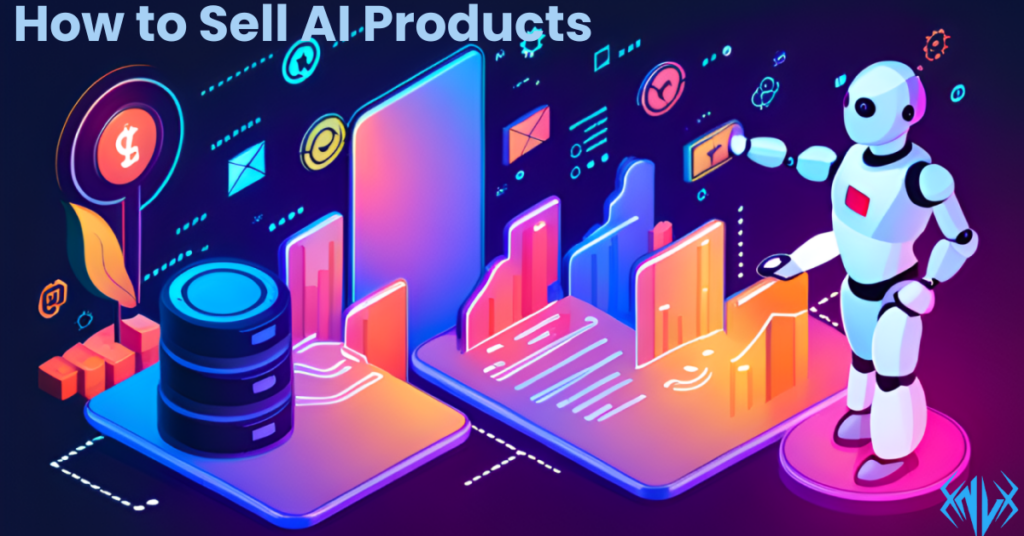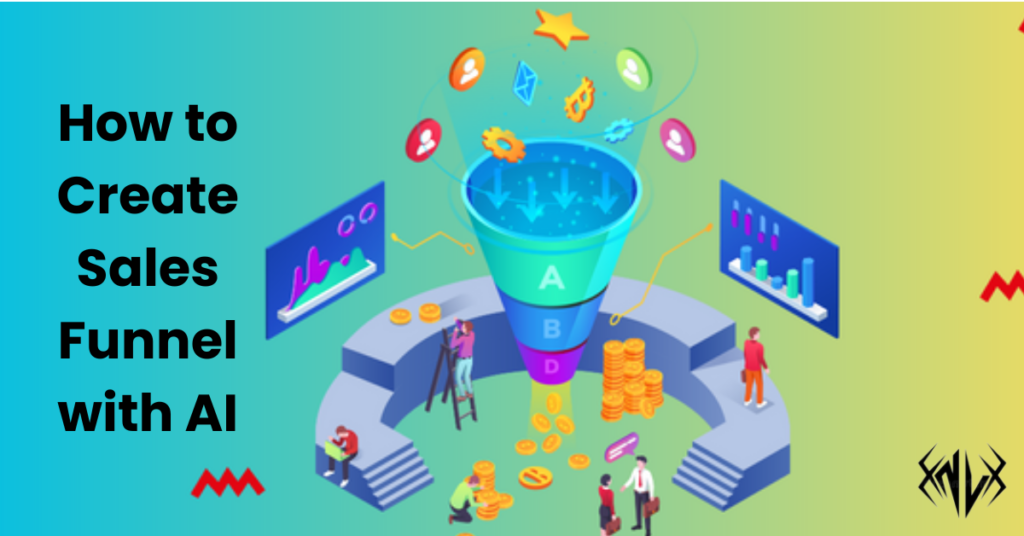Artificial intelligence (AI) is making big changes in businesses everywhere.
But, many people overlook the importance of having strong sales and marketing teams to sell AI products well.
They don’t realize that selling AI products requires a specific approach to communicate their value effectively.
In my experience, I’ve noticed that selling AI products isn’t always easy.
Potential buyers often don’t fully understand what AI can do, which makes them hesitant to invest in these solutions.
Through my journey, I’ve learned important lessons about selling AI products, from crafting compelling pitches to providing support.
One important part of selling AI products is building trust with customers. Using real data and examples, I’ve been able to show how AI can solve problems and bring benefits.
Adapting to each customer’s needs and offering fair pricing has also helped me build strong relationships.
Recent statistics show that AI is becoming more popular in businesses.
According to the latest McKinsey Global Survey, one-third of companies are now using AI regularly in at least one part of their business.
This shows that AI is no longer just a topic for tech experts; it’s something that business leaders are taking seriously.
In this blog post, we’ll explore practical strategies and real experiences to help you sell AI products better.
Whether you’re new to sales or have been doing it for a while, this information will give you the tools you need to succeed in the world of AI sales.
Let’s dive in and learn how to sell AI products effectively.

Benefits of Selling AI Products in Business
In today’s business landscape, selling AI products offers a myriad of benefits that can propel companies forward.
As someone deeply involved in the AI industry, I’ve witnessed firsthand the transformative impact AI can have on businesses across various sectors.
Let’s explore the compelling advantages of selling AI products in business:
1. Revenue Growth
When businesses sell AI products, they can make more money because the market for AI software is growing quickly.
According to Gartner, this market is expected to reach $135 billion by 2025, which means there’s a lot of potential for companies to earn profits.
2. Improved Efficiency
AI tools can help businesses work faster and better. For example, AI data analytics tools can quickly analyze large amounts of information, making it easier for companies to make smart decisions.
3. Cost Savings
By using AI, businesses can save money. This is because AI can automate tasks, reducing the need for manual work and preventing mistakes. For instance, predictive maintenance algorithms can help companies avoid costly equipment breakdowns.
4. Competitive Edge
Selling AI products can help businesses stay ahead of their competitors. With AI, companies can predict what customers want and come up with new ideas faster.
This makes them more attractive to customers and helps them grow their business.

How I Can Start an AI business
Starting an AI business requires careful planning and execution. Let’s break down the essential steps to launch a successful AI startup:
1. Research
Before you start, it’s vital to research the market, customer needs, and potential competitors thoroughly.
According to Gartner, the global AI software market is projected to reach $135 billion by 2025, indicating significant opportunities for AI businesses.
By gathering insights, you can identify profitable niches and develop a clear roadmap for your venture.
2. Build a Strong Team
Assembling a talented and diverse team is crucial for success. Look for individuals with expertise in AI development, data science, and business strategy. A study by McKinsey highlights the importance of diverse teams, showing that companies with diverse teams outperform others by 35%.
3. Have a Clear Vision
Define a clear vision and mission for your AI business, outlining your goals, values, and target market. Research suggests that companies with a clear vision are 3.5 times more likely to succeed.
A well-defined vision will guide your decisions and inspire others to join your journey.
4. Prototype Development
Develop a prototype of your AI product or service to demonstrate its feasibility and potential value to investors and customers.
According to Harvard Business Review, 75% of startups that develop a prototype secure funding.
Iteratively refine your prototype based on feedback and testing to meet market demands.
5. Secure Funding
Seek funding from investors, venture capitalists, or government grants to finance your AI startup’s development and growth.
Research shows that the number of AI startups funded globally increased by 44% in the last year.
Prepare a compelling pitch deck and business plan to attract potential investors and secure the necessary capital.
6. User Feedback
Gather feedback from early adopters and potential customers to validate your product concept and identify areas for improvement.
According to Forbes, 90% of startups fail due to building a product nobody wants. Incorporate user insights into your product development process to create a solution that resonates with your target audience.
7. Product Development
Continuously iterate and refine your AI product based on user feedback, market dynamics, and technological advancements.
According to Deloitte, 63% of consumers expect AI to provide personalized recommendations.
Focus on delivering value and addressing customer pain points to ensure the success of your AI business.
8. Marketing Strategy
Develop a comprehensive marketing strategy to promote your AI startup and attract customers.
Utilize digital marketing channels, content marketing, and networking opportunities to raise awareness and generate leads for your business.
According to HubSpot, 61% of marketers say improving SEO and growing their organic presence is their top inbound marketing priority.

AI Business Ideas that You can Start
Let’s delve deeper into ten profitable AI business ideas that could be promising ventures for aspiring entrepreneurs in 2024:
1. AI Art, Patterns, Images, And Stock Photo
You may make incredible AI art, images, patterns, and stock photos with AI art generators like Midjourney, Leonardo AI, Playground AI, and others. You can then sell these creations on various online markets including Redbubble, Etsy, Creative Market, and Society 6.
Using customer-supplied photos and an image-to-image function in an art generator to create custom art is one of the simplest ways to create custom art offerings.
2. Coloring Books And Storybooks
You may make black-and-white pictures to use as coloring books with AI art generators.
Choose an ever-trendy subject (cars, anime, dinosaurs, etc.) or one that is now trending (use Google Trends), design it using Canva for example, package it using Amazon KDP (Kindle Direct Publishing), and begin selling it online.
Making a storybook is another approach to market AI digital products online. With ChatGPT, creating a gripping plot and cast of characters is simple.
Then use the story, characters, theme, and setting to guide Midjourney to create art for your book. The difficult part is to make the characters look consistent.
3. Videos, Stock Music, And Sound Effects
Videos can be made with AI even in the absence of actors, cameras, or microphones.
You can create text-to-video content using technologies like FlexClip, Synthesia, and InVideo. Additionally, you may use the greatest image-based AI art generators to generate an AI avatar, animate it, and use it to make YouTube videos.
Offering video editing services and using AI to help with the process is one way to generate revenue.
4. Virtual backgrounds
You can utilize virtual backgrounds for Zoom calls, YouTube videos, and conference calls.Although creating virtual backgrounds is simple, selling them can be more difficult. With any AI art generator, virtual backgrounds can be produced.
Don’t forget to set the resolution to at least 1920 x 1080 and the aspect ratio to 16:9. If necessary, you can enlarge the image using an AI image upscaler.
5. AI-driven Fraud Detection Firm
Imagine creating software that can detect and prevent fraudulent activities across various industries like finance, e-commerce, and healthcare. For instance, banks can use AI algorithms to identify suspicious transactions and prevent financial fraud.
6. AI-generated Content Detection Software
Consider developing software tools capable of identifying and verifying AI-generated content to combat misinformation and fake news online.
This could be crucial for social media platforms and news outlets to maintain credibility and trustworthiness.
7 Personalized Education based on AI
Think about offering AI-driven educational platforms that deliver personalized learning experiences tailored to individual students’ needs and preferences. For example, an AI-powered tutoring app could adapt to each student’s learning style and pace, helping them grasp concepts more effectively.
8. AI-powered Virtual Health Assistance
Picture developing virtual health assistants powered by AI technology to provide personalized medical advice, symptom analysis, and healthcare recommendations. These assistants could enhance access to healthcare services and support patients in managing their health proactively.
9. AI-based Chatbot Solutions
Envision creating AI chatbots for businesses to automate customer support, sales, and lead generation processes. For instance, an e-commerce company could use AI chatbots to assist customers with product inquiries, order tracking, and payment processing, improving efficiency and customer satisfaction.
10. E-recruitment Automation Application
Explore building AI-driven recruitment platforms that automate candidate sourcing, screening, and matching processes.
This could streamline hiring for businesses by identifying qualified candidates more efficiently and reducing manual workload for recruiters.
11. AI Video Generator Software
Think about developing AI software capable of generating personalized video content for marketing campaigns, social media, and online presentations.
This could enable businesses to create engaging video content quickly and cost-effectively, enhancing their brand visibility and engagement.
12. AI Solutions for Retail Companies
Consider offering AI-powered solutions for retail businesses, including inventory management, demand forecasting, and customer analytics.
For example, AI algorithms could analyze sales data to predict demand trends, optimize inventory levels, and personalize marketing strategies to drive sales and profitability.
13. Logistic and Supply Chain Application Startup
Imagine starting an AI-driven logistics and supply chain management platform that optimizes transportation routes, inventory management, and warehouse operations for businesses.
This could help companies reduce costs, improve efficiency, and enhance overall supply chain performance.
14. AI-based Marketing Strategy Tools
Explore developing AI-powered marketing tools that analyze consumer behavior, predict market trends, and recommend targeted marketing strategies for businesses.
These tools could help companies optimize their marketing efforts, increase sales, and achieve a higher return on investment (ROI).

20 Amazing Steps on How to Sell AI Products
1. Understand Customer Pain Points
Understanding customer pain points is crucial when it comes to selling AI products.
This involves identifying specific challenges or problems that potential customers encounter, where your AI solution can offer a viable solution.
By doing so, you can tailor your product to meet the unique needs of your target audience, making it more appealing and valuable to them.
Imagine you’re selling AI-powered customer service chatbots to businesses.
You would need to understand the pain points these businesses face in their customer support processes.
This might include issues such as long wait times for customer inquiries, difficulty in handling peak hours, or high costs associated with hiring and training human agents.
By identifying these pain points, you can position your AI chatbot as a solution that addresses these challenges effectively.
For example, your chatbot could offer 24/7 support, respond to inquiries instantly, and handle multiple customer queries simultaneously.
This not only improves the efficiency of the customer support process but also reduces costs for the business.
Similarly, if you’re selling AI-driven inventory management software to retailers, you would need to understand the pain points they experience in managing their inventory.
This could include issues such as overstocking, stockouts, or inaccurate inventory forecasting.
With this understanding, you can develop an AI solution that optimizes inventory levels, predicts demand accurately, and streamlines the overall inventory management process.
By addressing these pain points, your AI product becomes indispensable to retailers, helping them save costs, improve efficiency, and enhance customer satisfaction.
8 Ways to Identify Customers Pain Points
- Customer feedback
- Conduct qualitative market research
- Map journeys
- Interview customers
- Conduct surveys
- Ask questions
- Apply social listening
- Perform competitor analysis
2. Research Target Industries
Researching target industries is crucial for effectively selling AI products.
This involves conducting thorough research to understand which industries or sectors have a high demand for AI solutions.
By identifying these industries, you can tailor your sales approach accordingly, focusing your efforts on areas where your AI product is most likely to succeed.
Imagine you’re selling AI-powered cybersecurity solutions.
Through research, you may discover that industries such as banking, healthcare, and e-commerce have a high demand for cybersecurity solutions due to the sensitive nature of their data and the increasing threat of cyberattacks.
By understanding this demand, you can tailor your sales approach to target these specific industries.
You can highlight how your AI cybersecurity solution addresses their unique security challenges, such as protecting sensitive financial information in the banking sector or safeguarding patient data in the healthcare industry.
Similarly, if you’re selling AI-driven marketing analytics software, you might find that industries such as retail, e-commerce, and digital advertising have a high demand for advanced analytics tools to optimize their marketing campaigns and improve ROI.
In this case, you can customize your sales pitch to showcase how your AI analytics solution can help businesses in these industries better understand their customers, target their marketing efforts more effectively, and ultimately drive sales growth.
3. Build a Compelling Value Proposition

Developing a clear and compelling value proposition is essential for successfully selling AI products.
Your value proposition should highlight the unique benefits and advantages of your AI product compared to competitors.
By effectively communicating the value that your product brings to customers, you can differentiate yourself in the market and attract potential buyers.
Imagine you’re selling AI-powered customer service chatbots.
Your value proposition could emphasize how your chatbot provides 24/7 support, responds instantly to customer inquiries, and reduces customer service costs compared to traditional human agents.
Similarly, if you’re offering AI-driven inventory management software, your value proposition might focus on how your solution optimizes inventory levels, reduces stockouts, and improves forecasting accuracy, leading to cost savings and increased efficiency for businesses.
In both cases, it’s essential to clearly articulate the specific benefits and advantages that your AI product offers.
This could include improved productivity, cost savings, faster decision-making, or enhanced customer experiences.
To build a compelling value proposition, you should also consider the pain points and challenges that your target audience faces and demonstrate how your AI solution addresses these issues effectively.
By developing a clear and compelling value proposition, you can effectively communicate the unique benefits of your AI product to potential customers, differentiate yourself from competitors, and ultimately drive sales success.
4. Create Demo Presentations

Preparing interactive demo presentations is a crucial step in selling AI products effectively.
These presentations allow potential customers to see the features and capabilities of your AI product in action, helping them better understand its functionality and value.
By showcasing your AI product through demos, you can engage potential customers and demonstrate how it can address their specific needs and challenges.
Imagine you’re selling AI-driven virtual health assistance software to healthcare providers. Your demo presentation could include simulated patient interactions, where the virtual assistant provides medical advice, schedules appointments, and answers common health-related questions.
This allows healthcare professionals to see firsthand how the AI solution can improve patient care and streamline administrative tasks.
Similarly, if you’re offering AI-powered marketing analytics software, your demo presentation might showcase real-time data visualization, predictive analytics capabilities, and personalized campaign recommendations.
By demonstrating how your AI solution can help businesses analyze customer behavior, optimize marketing strategies, and drive sales, you can convince potential customers of its value.
In both cases, it’s essential to tailor your demo presentations to the specific needs and interests of your target audience.
Highlight the key features and benefits of your AI product that are most relevant to them, and address any concerns or objections they may have.
By creating interactive demo presentations, you can provide potential customers with a hands-on experience of your AI product, allowing them to visualize its potential impact on their business.
This can significantly increase their confidence in your solution and improve your chances of closing deals.
You can use tools like Demo Builder, Storylane or PowerPoint to craft your demo presentation.
4 Tips to Ace Your Next Demo Presentation
- Understand Your Audience
- Hit Their Pain Points and Solve Their Problems
- Save Your Time by Using Templates
- Keep it Simple
5. Offer Free Trials or Pilot Programs

Offering free trials or pilot programs is a strategic approach to selling AI products.
These initiatives provide potential customers with the opportunity to try out your AI product firsthand, allowing them to experience its benefits and functionalities before making a purchasing decision.
By offering free trials or pilot programs, you can showcase the value of your AI product and build trust with potential customers.
Imagine you’re selling AI-driven project management software to businesses. Offering a free trial period allows potential customers to explore the features and capabilities of your software, such as task management, collaboration tools, and automated reporting.
This hands-on experience enables them to assess whether the software meets their specific project management needs and objectives.
In like manner, if you’re offering AI-powered language translation services, providing a pilot program allows potential customers to test the accuracy, speed, and reliability of your translation technology.
By integrating your solution into their existing workflows or applications, they can evaluate its performance in real-world scenarios and determine its suitability for their language translation requirements.
In both cases, it’s essential to offer clear guidelines and support during the free trial or pilot program to ensure a positive experience for potential customers.
Provide resources such as user guides, tutorials, and customer support channels to help them maximize the value of the trial period and address any questions or concerns they may have.
By offering free trials or pilot programs, you not only give potential customers the opportunity to experience the benefits of your AI product firsthand but also demonstrate your confidence in its capabilities.
This can help alleviate any doubts or hesitations they may have about investing in your solution and increase the likelihood of conversion to paying customers.
Types of Free Trials That You Can Offer
1. Time-limited Variety
This type of free trial allows customers to use a product or service for a predetermined length of time before having to pay for it.
This is a great way to get customers interested in your product and allow them to try it out before making a commitment.
2. Money-back Guarantee
This type of trial allows customers to try a product or service and receive their money back if they are not satisfied with it.
This encourages customers to take a chance on the product and gives them confidence in the quality of the product. It also gives them an easy out if they don’t like what they’ve tried.
3. Limited Feature Trial
This type of trial gives customers access to a limited version of the product or service for a certain amount of time.
This allows customers to get a feel for the product before committing to purchasing it. It also helps customers make sure that the product meets their needs and expectations before making an investment.
4. Full-featured Trial
This type of trial grants customers access to all features of a product or service for a set period of time. This allows customers to test out all features of a product before committing to purchase it.
This type of trial is especially beneficial for those who are considering investing in a more expensive product or service and want to make sure they get what they pay for.
6. Customize Solutions for Each Client

s Tailoring solutions to suit individual clients is pivotal in the realm of selling AI products.
This strategy entails delving into the unique needs, objectives, and obstacles of each client and presenting bespoke AI solutions that cater to their distinct requirements.
By adopting a personalized approach, you showcase a dedication to fulfilling the precise demands of each client, thereby enhancing the prospects of a successful transaction.
Consider, for instance, marketing AI-powered data analytics software to businesses across various sectors.
Each client might possess specific data origins, analysis aims, and reporting preferences.
By meticulously grasping their particular requisites, you can tailor the solution to seamlessly integrate with their current systems, analyze pertinent data sets, and yield actionable insights aligned with their business objectives.
Likewise, if you’re pitching AI-driven customer relationship management (CRM) solutions, you may encounter clients with diverse sales methodologies, customer segmentation tactics, and communication preferences.
By customizing the CRM solution to meet their unique needs, you ensure it harmonizes with their workflows, captures pertinent data points, and facilitates effective engagement with their clientele.
In both scenarios, proactive engagement with clients is paramount to glean insights into their operational processes, pain points, and aspirations.
This proactive approach might involve conducting discovery sessions, workshops, or surveys to gather pertinent information and foster a deeper comprehension of their requirements.
By tailoring solutions to the individual needs of each client, you underscore the efficacy of your AI product in addressing their specific challenges and driving tangible business outcomes.
This personalized strategy not only heightens the probability of securing deals but also nurtures enduring client relationships founded on trust, collaboration, and mutual prosperity.
7. Leverage Data and Case Studies
Using data and case studies is a smart move when selling AI products.
It helps to prove how effective and profitable your AI product can be, which builds trust with potential customers.
For example, let’s say you’re selling AI software for analyzing customer behavior to retail stores.
You could show how your software boosted sales and made customers happier.
You might share a story about how one store saw a big jump in revenue after using your AI tool.
Similarly, if you’re selling AI software to predict when machines need maintenance for factories, you could use data from past projects to show how your software saved money by reducing downtime and extending the life of equipment.
In both cases, it’s crucial to use specific numbers and examples to back up your claims.
This might include stats like increased revenue, lower costs, or happier customers. By giving real proof of how your AI product can benefit them, you make it easier for potential customers to say yes.
Using data and case studies helps you show potential customers why your AI product is worth buying.
It builds trust and confidence, which makes it more likely that they’ll choose to work with you.
8. Provide Comprehensive Training and Support

It’s very important in the world of AI product sales to provide thorough training and ongoing help.
It makes sure that customers know how to use the product well and can get help whenever they need it.
Customers will be happy and likely to stick with the product for a long time, which will help it succeed.
For example, if you sell AI software to automate sales, giving your sales teams thorough training is a good way to help them learn how to use it well.
They can learn how to do things like manage leads, automate jobs, and keep track of performance, which makes things run more smoothly and brings in more money.
Also, if you sell AI-based customer service options, make sure your customers can get help whenever they need it by offering ongoing support.
This could mean having access to a help team, online tools, and regular software updates.
Training and help should be made to fit the needs of each customer. To suit different ways of learning, give people a choice of workshops, webinars, and online courses.
Also, make sure that your help team is easy to reach and quick to respond to any issues.
Customers will know that you care about their success if you give them thorough training and help.
This makes people believe and like you more, which makes relationships stronger and helps your AI business grow.
9. Establish Thought Leadership

To sell AI products, you need to establish yourself as a thought leader.
Getting yourself and your company known as AI experts means sharing useful information, ideas, and skills through different outlets, like blogs, white papers, webinars, and speaking engagements.
Let’s say you sell marketing automation software that is driven by AI.
To become a thought leader, you could write blog posts and white papers about new trends in marketing automation, the best ways to use AI in marketing campaigns, and case studies that show how AI-driven marketing strategies have worked in the past.
You can also share your knowledge and meet with potential customers who are looking for help using AI for marketing by holding webinars or giving talks at industry conferences.
Also, if you sell cybersecurity solutions that are powered by AI, you could show that you’re a thought leader by writing study papers and articles about cybersecurity threats, how to protect against them, and the role of AI in making cybersecurity stronger.
You could also lead workshops or take part in panel discussions about cybersecurity at events for your business.
This would help you become known as a trusted expert in the area.
Thought leadership not only shows that you are an expert and trustworthy person in the AI field, but it also brings in possible customers who are looking for help and advice in their own fields.
By doing this, people will trust and believe in your company more, making you the best choice for AI products and services.
10. Network and Build Relationships

Building relationships and networking are important parts of selling AI goods well.
Going to conferences, events, and networking opportunities in your field is a great way to meet possible customers, business partners, and AI ecosystem influencers.
By actively taking part in networking events, you can make meaningful connections, grow your professional network, and open up chances to work together and grow.
Let’s say you’re selling marketing analytics software that is driven by AI.
You can meet marketing professionals, business owners, and people in charge who could use your AI answer by going to marketing conferences and other events in the field.
You can show off your product, talk about their unique needs and problems, and look into possible partnerships or collaborations by networking with these people.
Also, if you’re selling AI-powered healthcare solutions, going to medical conferences and networking events is a great way to meet healthcare providers, managers, and experts in the field.
Building relationships with important people in the healthcare field can help you learn about business trends, government rules, and new ways that AI can be used in healthcare.
When networking in either situation, it’s important to be yourself, show attention, and be ready to listen and learn from others.
Focus on making real connections with possible partners and customers and building trust and a good relationship with them.
After networking events, be sure to follow up with people you met and keep in touch with them over time.
Look for ways to work together or get more involved.
You can make your AI product more visible, learn more about market needs and trends, and eventually find more business opportunities by actively networking and building relationships in the AI ecosystem.
Networking in the AI business not only helps with sales and partnerships, but it also builds a sense of community and encourages people to work together.
11. Offer Flexible Pricing Models
For AI products to sell well, they need to have flexible pricing models.
Offering different pricing choices, like subscription-based pricing, pay-per-use pricing, or custom pricing packages, lets you meet the needs and budgets of a wide range of potential customers.
When you give flexible pricing, you can get more customers, make your AI product easier for more people to use, and increase sales.
Let’s say you sell businesses data analysis software that is driven by AI.
Customers can pay a monthly or yearly fee to access the software when you offer subscription-based price.
This makes it easier for them to budget and keep track of their spending.
This pricing plan works best for companies that want to know their costs ahead of time and need a long-term solution for their data analytics needs.
A similar example is pay-per-use pricing for AI-driven customer service solutions. This way, customers only pay for the tools or services they actually use.
This pricing plan is flexible, which is good for businesses whose customer service needs change or whose workload changes with the seasons.
Customers will only pay for what they need, which keeps costs low and worth high.
In both situations, it’s important to have clear pricing and information about the features and perks that come with each plan.
Give customers the option to change or upgrade their payment plans as their needs change.
This way, they can use the AI product in a way that fits the needs of their business.
By giving customers a choice of pricing options, you can lower the barriers to adoption, meet the needs of a wide range of potential customers, and eventually increase sales and profits for your AI business.
Being able to change your prices shows that you care about your customers and are willing to work with their specific tastes and budgets.
12. Address Security and Compliance Concerns

When selling AI products, it’s important to address concerns about security and compliance.
To do this, you need to be proactive and make sure that your AI technologies meet the highest levels of security and follow all industry rules.
Imagine that you are selling healthcare companies data analytics software that is driven by AI.
To fix security issues, you need to use encryption protocols, access limits, and data anonymization methods to keep private patient data safe and follow rules like the HIPAA (Health Insurance Portability and Accountability Act).
To handle compliance issues if you provide AI-powered financial forecasting solutions, you must make sure that your software follows rules like GDPR (General Data Protection Regulation) and SOX (Sarbanes-Oxley Act).
To protect financial data and make sure that regulatory rules are followed, this could mean putting in place audit records, data governance policies, and role-based access controls.
For possible customers to feel comfortable, it’s important to be clear about your policies on data privacy, security, and compliance.
This could mean putting out privacy policies, doing security checks, and getting third-party certifications to show that you are serious about keeping customer data safe and secure.
You can build trust and confidence with potential customers, get past objections, and speed up the sales process by effectively addressing security and compliance concerns.
You can then market your AI goods as solutions that you can rely on and that meet the strictest security and compliance standards in their fields.
13. Highlight Scalability and Integration

To successfully sell your AI product to potential customers, you need to stress how scalable it is and how easy it is to integrate.
By focusing on these areas, you can show how flexible and adaptable your AI solution is, making it easy for users to use and connect with their current systems and processes.
Let’s say you sell businesses software that uses AI to predict sales.
When you talk about your product’s flexibility, you should stress that it can handle a lot of data and grow with the customer’s business.
For instance, as the customer’s business grows, your software should be able to handle more and more sales data without slowing down or losing accuracy.
Similarly, if you want to show how easy it is to integrate your AI product, you should show that it works with a number of software systems and platforms that your users probably already use.
For example, if your AI solution works well with well-known CRM (Customer Relationship Management) programmes like HubSpot or Salesforce, users can easily add it to their current marketing and sales processes without having to make a lot of changes or do a lot of extra development work.
In both cases, it’s important to give customers clear instructions, paperwork, and support materials to help them through the integration process.
By showing that your AI product can be scaled up and integrated, you can ease potential customers’ worries about fit and implementation problems, making it more appealing to them.
To make your AI product seem like a flexible, future-proof option that can grow and change with your customers’ needs, stress how easy it is to integrate and how it can be scaled up or down.
This not only makes your product more valuable, but it also makes it more appealing and likely that potential buyers will buy it.
14. Provide Continuous Updates and Enhancements
For your AI product to be successful in the long run and keep your customers happy, you need to keep adding new features and changes.
You show that you want to improve the functionality, performance, and value of your AI solution over time by promising to offer regular updates and new features.
Let’s say you sell businesses project management software that is driven by AI.
You can fix bugs, add new features, and address issues by constantly updating and improving the software.
This will make it easier for people to use and more productive overall.
Based on customer comments and market trends, you might, for example, release updates that make it easier to handle tasks, add integrations with popular productivity tools, or make reporting and analytics better.
A similar example is if you use AI-powered chatbots for customer service.
Regular updates can help improve the chatbot’s natural language processing, answer accuracy, and knowledge base so it can handle a wider range of customer questions well.
You can make sure that your AI product stays competitive and useful in the market by keeping up with new technologies and changing customer needs.
In both cases, it’s important to get feedback from customers and use that feedback to prioritise changes and improvements that meet your users’ most pressing needs and pain points.
Also, be honest with your customers about future updates, new features, and improvements to keep them interested in your product and up to date.
By constantly adding new features and updating your AI product, you can set it apart from competitors, keep customers you already have, and get new ones.
This ongoing dedication to new ideas and betterment builds trust and loyalty among customers, which eventually helps your AI business succeed and grow.
15. Offer Proof of Concept Projects
A smart way to sell AI product is to offer proof of concept projects or pilot implementations.
This way, potential customers can see for themselves how useful and possible your solution is before committing to a full-scale rollout.
Using this method helps build trust, lowers risk, and boosts faith in your AI product’s abilities.
Let’s say you’re selling a manufacturing business AI-powered software for optimising their supply chain. By giving the customer a proof of concept project, you can test the software in a controlled setting, like a warehouse or delivery centre, to see how well it works at improving inventory management, lowering costs, and making logistics operations run more smoothly.
During the proof of concept process, you can show the customer measurable results and return on investment (ROI).
This will help them see the value of your AI solution and make it easier for their whole organisation to adopt it.
For the same reason, if you’re selling AI-powered predictive maintenance solutions for industrial equipment, letting the customer try them out first lets you see how well the solution works at lowering downtime, making equipment more reliable, and keeping maintenance costs low.
During the pilot phase, keeping an eye on key performance indicators and metrics will help you figure out how useful your AI product is and fix any problems or issues before deploying it on a larger scale.
It’s important to work closely with the customer to set clear goals, success factors, and timelines for the proof of concept or pilot project in both cases.
Give ongoing help, training, and direction to make sure the implementation goes smoothly and increase the chances of success.
You can successfully show potential customers the value of your AI product, build credibility with them, and speed up the sales cycle by offering proof of concept projects or pilot implementations.
Customers can make smart choices based on real-life evidence, and this hands-on method sets the stage for long-term partnerships and success.
16. Utilize Social Proof and Testimonials

A great way to sell AI product is to use social proof and testimonials. This helps potential buyers believe in and trust your product.
By showing testimonials and good experiences from happy customers, you can reassure potential buyers that your AI solution works and is reliable, which will ultimately make them more confident in their decision to buy.
Let’s say you sell businesses marketing automation software that is driven by AI.
By showing reviews from businesses that have used your product to improve their marketing, get more leads, and make more sales, you can show that it really does work and has real benefits.
As an example, a testimonial about how your AI solution helped a small business double its website traffic and sales rates can be very convincing proof of how well it works.
Also, if you’re selling AI-powered customer service solutions, showing case studies or success stories from clients who have seen big gains in customer satisfaction, response times, and business efficiency can help people trust you more.
For example, a case study showing how your AI-powered chatbot helped a big company cut its customer service costs by 30% and boost customer satisfaction can really connect with people who are going through the same problems.
When you show social proof and testimonials, make sure they are clear and real, and use real quotes, data, and results whenever you can.
Use different platforms, like your website, marketing materials, social media, and industry events, to show off social proof.
This will help you contact more potential buyers.
You can use the good experiences of current customers to influence and persuade potential customers by using social proof and recommendations.
This method not only helps you get past complaints and scepticism, but it also strengthens the value proposition of your AI product, which makes it more appealing to potential buyers.
17. Offer Educational Resources
One of the best ways to sell AI products is to give customers educational materials. These help customers learn how to use the technology and get the most out of it.
You can help customers all the way through their journey with your AI product, from getting started to mastering it, by giving them tutorials, guides, and paperwork.
Let’s say you sell businesses data analysis software that is driven by AI.
You can help people get the most out of your software and feel confident making decisions based on data by giving them in-depth lessons and guides on things like data visualisation techniques, predictive modelling, and machine learning algorithms.
Giving people step-by-step instructions on how to make predictive models or custom dashboards is one way to help them make good use of advanced analytics features.
In the same way, if you offer AI-powered chatbots for customer service, giving users documentation on the best ways to create conversational flows, improve response accuracy, and look at chatbot performance metrics can help them make their chatbot deployments more effective.
You can make sure your customers get the most out of your product by giving them the information and tools they need to create, deploy, and improve AI-powered chatbots.
It’s important to make teaching materials that are clear, to the point, and easy for people of all skill levels to use in both situations.
To accommodate different ways of learning, you might want to provide a mix of written guides, online tutorials, and hands-on demos.
Also, ask your customers for feedback so that you can keep improving and adding to your educational programmes based on their changing wants and problems.
By giving people educational materials, you show that you care about their success and give them the tools they need to get the most out of your AI product.
This method not only makes customers happier and more loyal, but it also makes your brand look like a reliable partner on their way to adopting AI and coming up with new ideas.
18. Streamline the Sales Process

When it comes to selling AI products, the sales process needs to be sped up.
To do this, automation tools, CRM systems, and standard routines must be used to make the sales process faster and better.
Let’s say you sell businesses marketing automation software that is powered by AI. You can use automation tools to find and qualify leads automatically by streamlining the sales process.
This cuts down on manual work and lets sales teams focus on high-potential possibilities.
Similarly, if you sell AI-based customer relationship management (CRM) tools, streamlining the sales process means using CRM systems to keep track of contacts with leads and customers, handle follow-ups, and look at how well sales are going. This helps sales teams stay organised, decide which jobs are most important, and close deals faster.
Standardized routines are a good way to make sure that the sales process is consistent and runs smoothly.
This could mean setting clear steps in the sales pipeline, making sure leads meet certain criteria, and setting up automated follow-up sequences.
You can boost output, cut down on sales cycles, and make more money by streamlining the sales process.
Therefore, you can concentrate on getting to know possible customers and giving them value through your AI products.
19. Provide Thoughtful Follow-Up

Following up with care is important if you want to sell AI product because it shows that you care about your customers and reinforces the value of your product.
You can answer potential customers’ questions and address their concerns by following up with them in a timely and friendly way.
You can also give them more information or help if they need it.
Let’s say you sell businesses software that automates sales that is driven by AI.
It’s important to follow up with possible customers after the first demo or consultation to get their feedback, clear up any questions they may have, and give them more information about how your solution can help them with their specific sales problems.
For example, writing a personalized email or setting up a follow-up call to talk about how to make the software fit the needs of the prospect’s business can help you get to know them and gain their trust.
In the same way, if you’re selling cybersecurity solutions that are powered by AI, thoughtful follow-up can mean giving them more tools or case studies that show how well your product protects them from cyber threats.
You can show the value of your AI solution and ease concerns about its effectiveness by answering any questions or doubts that the prospect still has and making suggestions based on their specific security needs.
When following up with a customer, it’s important to do so with a real desire to help and support them instead of just trying to make a sale.
Personalizing your message based on the prospect’s likes and dislikes and the times you’ve talked to them before can also help your follow-up efforts.
You can improve your relationships with potential customers and increase the chances of making a sale by showing that you are paying attention, responding, and ready to meet their needs.
20. Monitor and Measure Success

It’s important to keep track of and measure the results of your sales efforts if you want to sell AI products well and make your sales plan better over time.
You can learn a lot about how well your sales efforts are doing and find ways to make them better by keeping track of key metrics like conversion rates, customer satisfaction, and revenue produced.
Let’s say you sell businesses marketing automation software that is driven by AI.
By keeping an eye on conversion rates, you can figure out how well your sales process is working and find any spots where prospects may be leaving.
For instance, if you see a lot of people leaving during the demo stage, it could mean that you need to improve your demos or find better ways to answer common complaints.
Another important measure to keep an eye on is customer satisfaction, which shows how the overall experience was and how valuable the customer thought your AI product was.
Customers’ reviews or surveys after the sale can give you useful information about where your product does well and where it might not be as good.
For example, if you hear from customers that they are having trouble with onboarding or implementation, you can set aside resources to give them more training or help to fix these problems.
Lastly, keeping track of the money that comes in lets you see how your sales efforts affect your finances and figure out the return on investment (ROI) of your marketing and sales activities.
By looking at revenue data along with other important metrics, like customer acquisition prices and lifetime value, you can decide how to best use your resources and put the most importance on projects that will have the biggest effect on your bottom line.
If you want to improve your sales strategy and make your efforts more effective, you need to keep an eye on and measure success through key metrics like conversion rates, customer satisfaction, and income generated.
By using data-driven insights, you can find places to improve, make your sales processes more efficient, and eventually sell more AI products.
Read: Best AI Tools For Outbound Sales {To Go From Loser To Closer}
Final Thoughts on How to Sell AI Products
In wrapping up, selling AI products is like being a guide in a vast landscape.
It’s not just about selling; it’s about understanding customers, showing how our product helps, and building trust through expertise.
Being in AI sales, I’ve found success comes from adapting, innovating, and truly connecting with our audience.
It’s more than a product pitch; it’s about offering real solutions to real challenges and helping our clients thrive in a changing world.
In the AI realm, where possibilities are endless, our role is to be more than salespeople – we’re guides, problem-solvers, and visionaries.
We light the way for our customers to success.
So, as we journey together, let’s embrace challenges, savor victories, and keep pushing boundaries.
With determination and understanding, we’re not just selling AI products; we’re shaping the future of tech and humanity. Here’s to a journey of growth, transformation, and making a difference.


